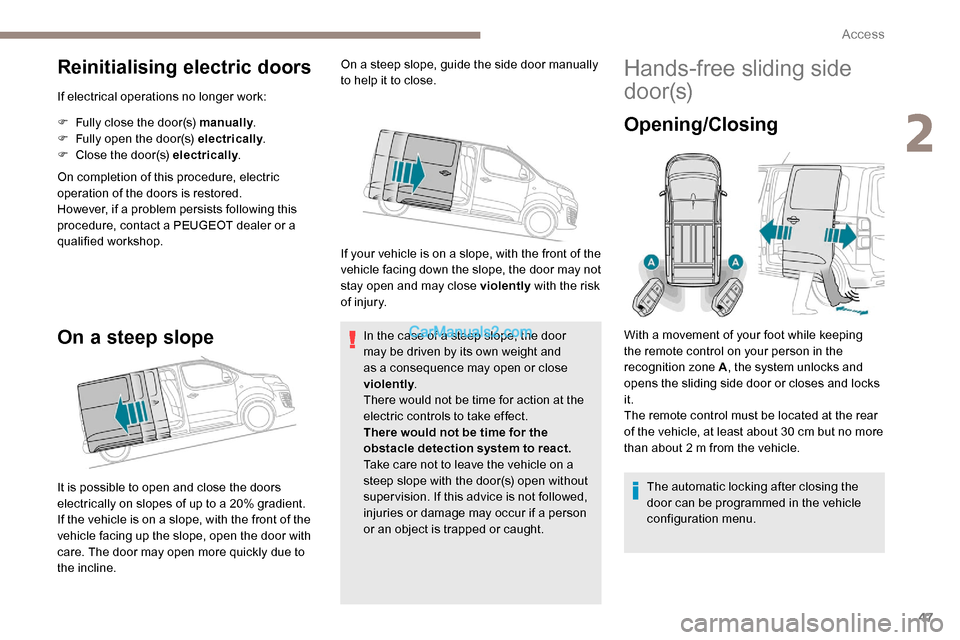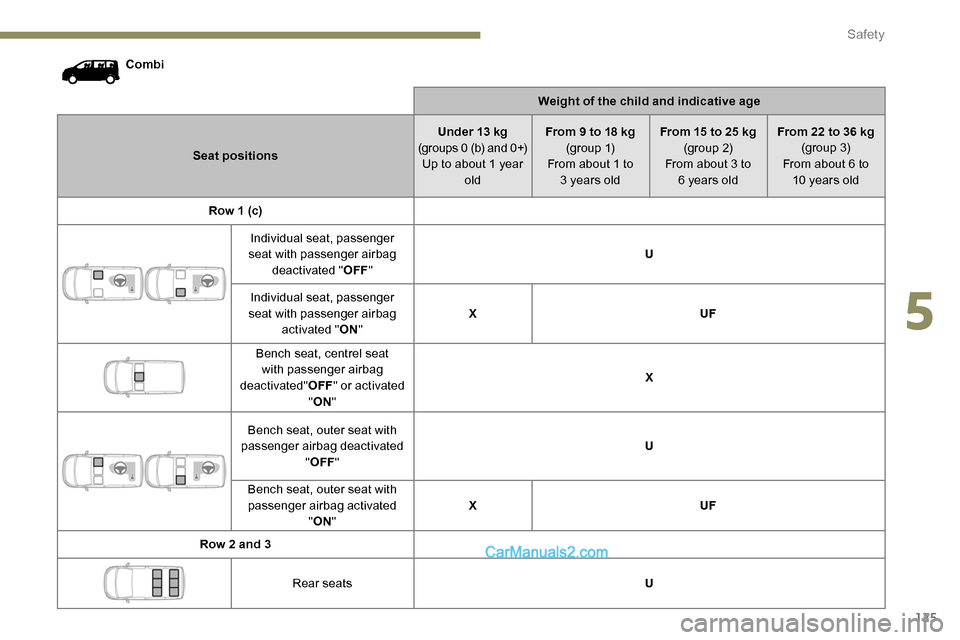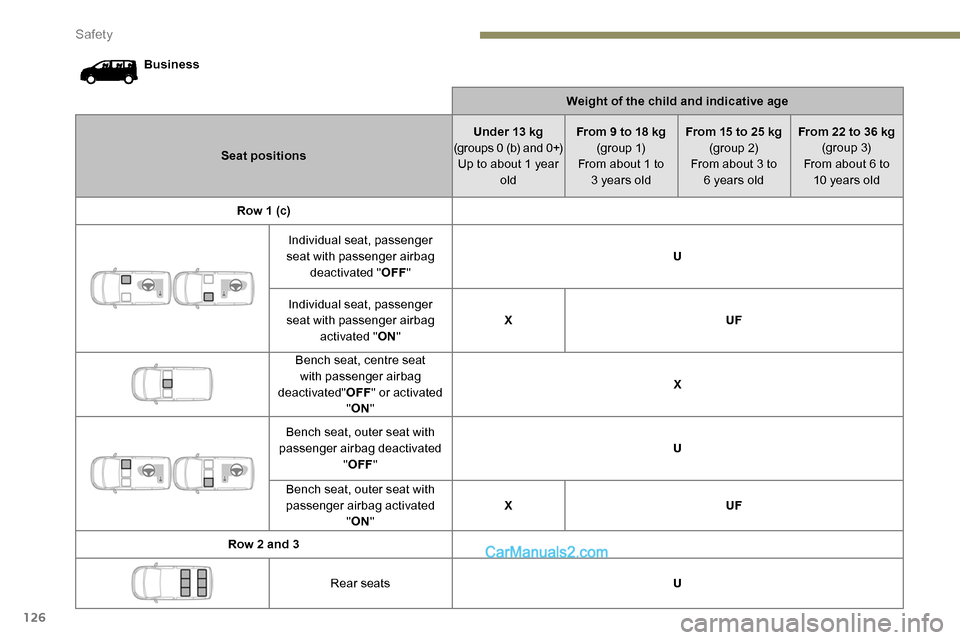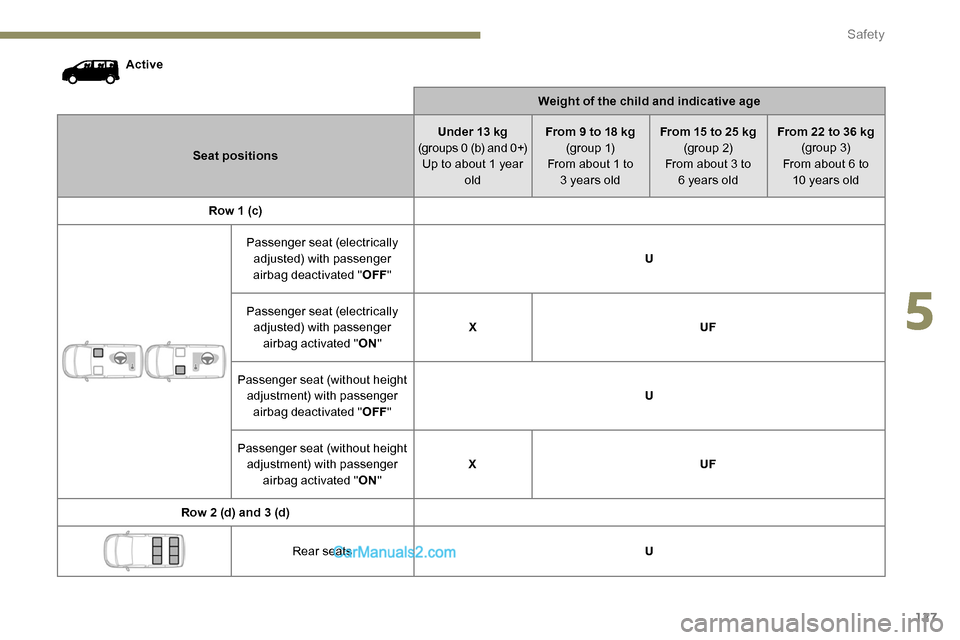2019 Peugeot Expert weight
[x] Cancel search: weightPage 49 of 324

47
Reinitialising electric doors
If electrical operations no longer work:
F
F
ully close the door(s) manually .
F
F
ully open the door(s) electrically .
F
C
lose the door(s) electrically .
On completion of this procedure, electric
operation of the doors is restored.
However, if a problem persists following this
procedure, contact a PEUGEOT dealer or a
qualified workshop.
On a steep slope
It is possible to open and close the doors
electrically on slopes of up to a 20% gradient.
If the vehicle is on a slope, with the front of the
vehicle facing up the slope, open the door with
care. The door may open more quickly due to
the incline. On a steep slope, guide the side door manually
to help it to close.
If your vehicle is on a slope, with the front of the
vehicle facing down the slope, the door may not
stay open and may close violently
with the risk
of injury.
In the case of a steep slope, the door
may be driven by its own weight and
as a consequence may open or close
violently .
There would not be time for action at the
electric controls to take effect.
There would not be time for the
obstacle detection system to react.
Take care not to leave the vehicle on a
steep slope with the door(s) open without
supervision. If this advice is not followed,
injuries or damage may occur if a person
or an object is trapped or caught.
Hands-free sliding side
d o o r (s)
Opening/Closing
The automatic locking after closing the
door can be programmed in the vehicle
configuration menu.
With a movement of your foot while keeping
the remote control on your person in the
recognition zone A
, the system unlocks and
opens the sliding side door or closes and locks
it.
The remote control must be located at the rear
of the vehicle, at least about 30 cm but no more
than about 2 m from the vehicle.
2
Access
Page 82 of 324

80
Recommendations on
loading
The weight of the load must comply with
the Gross Train Weight (GTW).
For more information on Engine
technical data and towed loads, refer to
the corresponding section.
If you are using a carrying system (roof
bars/roof rack), comply with the maximum
loads associated with this system.
For more information on Roof bars/Roof
rack , refer to the corresponding section.
Make sure that the size, shape and
volume of the loads carried are compatible
with the highway code and safety
regulations and do not impair the driver’s
field of vision.
Steel or glass partitions separate the loading
area from the cab.
The load must be evenly distributed in the
loading area so as not to inter fere with
driving the vehicle.
Place the load close to the side panels,
or even push it against the side panels
between the wheel arches.
However, it is recommended that heavy
objects are placed as close to the cab as
possible as a precaution in case of sharp
braking.
Firmly secure all parts of the load using
the stowing rings on the floor of the
loading area.
For more information on the Interior
fittings
and in particular on the stowing
rings, refer to the corresponding section. To avoid the risk of injury or accident, the
load must be made stable so that it cannot
slide, tip over, fall or be thrown. To do this,
use only retaining straps that conform to
current standards (DIN for example).
For more information on putting straps
in place, refer to the manufacturer’s user
guide.
There must not be any empty space
between the components of the load.
To prevent the load sliding, there must not
be any empty space between the load and
the panels of the vehicle.
As well as the straps, optimise the stability
of the load with stable handling equipment
(wedges, rigid blocks of wood or padding).
When washing your vehicle, never clean
the inside directly using a water jet.
Ease of use and comfort
Page 85 of 324

83
Retractable sliding table
Allure, Business VIP
It comprises a closed central storage space
with a lid. Unfolded, it provides a table with
two tops on which objects can be placed. The
central area includes two cup holders and can
also be used to place small objects (credit card,
pen, etc.).
The assembly is mounted on a runner allowing
it to be positioned either in row 2 or row 3.
Storage
F Slide back the cover for access to 11 litres of storage space.
The storage space can only support a
maximum weight of 3 kg; do not exceed
this maximum load in use.
Moving forward or
backward
F Lift the control (without going beyond the point of resistance) and slide the assembly
forwards or backwards. F
R
elease the control when it is in the desired
position.
F
C
heck that the table is secured on the
runner. If this is not the case, move the
assembly slightly to the next notch on the
r u n n e r.
You can move the table in both the open
and stowed position. However, to ensure
safety, it is advised that you handle the
assembly in the stowed position.
For the table to run smoothly, ensure that
no objects are blocking the space used by
the runner on the floor.
Before manoeuvring the table, check that
there is nothing on the table.
Unfolding
F Operate the control on the top and pull the table assembly up until it clicks into place.
3
Ease of use and comfort
Page 122 of 324

120
Curtain airbags
Lateral airbags
Use only approved covers on the seats,
compatible with the deployment of the
lateral airbags. For information on the
range of seat covers suitable for your
vehicle, contact a PEUGEOT dealer.
Do not fix or attach anything to the seat
backrests (clothes, etc.), as this could
cause injuries to the thorax or arm when
the lateral airbag is deployed.
Do not sit with the upper part of the body
any nearer to the door than necessary.
The vehicle's front door panels include
side impact sensors.
A damaged door or any unauthorised or
incorrectly executed work (modification or
repair) on the front doors or their interior
trim could compromise the operation of
these sensors - risk of malfunction of the
lateral airbags!
Such work must only be done by a
PEUGEOT dealer or a qualified workshop.
General points relating to
child seats
The legislation on carrying children is
specific to each country. Refer to the
legislation in force in your country. -
S
tatistically, the safest seats in your
vehicle for carr ying children are the rear
seats.
-
A c
hild weighing less than 9 kg must
travel in the "rear ward facing" position
both in the front and in the rear.
It is recommended that children travel on
the rear seats of your vehicle:
- "
rearward facing " up to the age of 3,
- "
forward facing " over the age of 3.
Ensure that the seat belt is positioned and
tightened correctly.
For child seats with a support leg, ensure
that the support leg is in firm and steady
contact with the floor.
At the front: if necessary, adjust the
passenger seat.
At the rear: if necessary, adjust the
relevant front seat.
Remove and stow the head restraint
before installing a child seat with backrest
on a passenger seat. Refit the head
restraint once the child seat has been
removed.
Active
, Allure , Business VIP
Do not fix or attach anything to the roof,
as this could cause head injuries when the
curtain airbag is deployed.
Do not remove the grab handles installed
on the roof, as they play a part in securing
the curtain airbags.
For maximum safety, please obser ve the
following recommendations:
-
I
n accordance with European regulations,
all children under the age of 12 or less
than one and a half metres tall must
travel in approved child seats suited to
their weight , on seats fitted with a seat belt
or ISOFIX mountings.
Safety
Page 126 of 324

124
Locations for child seats secured using the seat belt
Pursuant to European legislation, the table indicates the options for installing child seats secured using a seat belt and universally approved (a) for the
weight of the child and the seat in the vehicle.Weight of the child and indicative age
Seat positions Under 13 kg
(groups 0 (b) and 0+) Up to about 1 year old From 9 to 18 kg
(g r o u p 1)
From about 1 to 3 years old From 15 to 25 kg
(group 2)
From about 3 to 6 years old From 22 to 36 kg
(group 3)
From about 6 to 10 years old
Cab/Row 1 (c) (f )
Individual seat, passenger seat U
Bench seat, outer seat U
Bench seat, centre seat X
Row 2 (d) (Fixed bench seat)* Rear seats U
*
T
he folding bench seat is in the process of being approved.
Safety
Page 127 of 324

125
CombiWeight of the child and indicative age
Seat positions Under 13 kg
(groups 0 (b) and 0+) Up to about 1 year old From 9 to 18 kg
(g r o u p 1)
From about 1 to 3 years old From 15 to 25 kg
(group 2)
From about 3 to 6 years old From 22 to 36 kg
(group 3)
From about 6 to 10 years old
Row 1 (c) Individual seat, passenger
seat with passenger airbag deactivated " OFF" U
Individual seat, passenger
seat with passenger airbag activated " ON" X
UF
Bench seat, centrel seat with passenger airbag
deactivated" OFF" or activated
" ON " X
Bench seat, outer seat with
passenger airbag deactivated "OFF " U
Bench seat, outer seat with passenger airbag activated "ON " X
UF
Row 2 and 3 Rear seats U
5
Safety
Page 128 of 324

126
BusinessWeight of the child and indicative age
Seat positions Under 13 kg
(groups 0 (b) and 0+) Up to about 1 year old From 9 to 18 kg
(g r o u p 1)
From about 1 to 3 years old From 15 to 25 kg
(group 2)
From about 3 to 6 years old From 22 to 36 kg
(group 3)
From about 6 to 10 years old
Row 1 (c) Individual seat, passenger
seat with passenger airbag deactivated " OFF" U
Individual seat, passenger
seat with passenger airbag activated " ON" X
UF
Bench seat, centre seat with passenger airbag
deactivated" OFF" or activated
" ON " X
Bench seat, outer seat with
passenger airbag deactivated "OFF " U
Bench seat, outer seat with passenger airbag activated "ON " X
UF
Row 2 and 3 Rear seats U
Safety
Page 129 of 324

127
ActiveWeight of the child and indicative age
Seat positions Under 13 kg
(groups 0 (b) and 0+) Up to about 1 year old From 9 to 18 kg
(g r o u p 1)
From about 1 to 3 years old From 15 to 25 kg
(group 2)
From about 3 to 6 years old From 22 to 36 kg
(group 3)
From about 6 to 10 years old
Row 1 (c)
Passenger seat (electrically adjusted) with passenger
airbag deactivated " OFF" U
Passenger seat (electrically adjusted) with passenger airbag activated " ON" X
UF
Passenger seat (without height adjustment) with passenger airbag deactivated " OFF" U
Passenger seat (without height adjustment) with passenger airbag activated " ON" X
UF
Row 2 (d) and 3 (d) Rear seats U
5
Safety